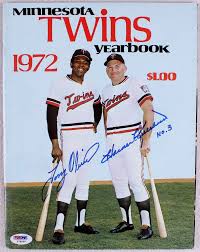
When I discuss Tony Oliva with baseball fans, a common occurrence at SABR 46 in July, inevitably Tony’s bat-throwing comes up. He was prone to heave bats into on-deck circles, across infields, and sometimes into the stands. There’s a remarkable story linked to Tony’s bat-throwing.
In May 1964, early in his rookie season, Tony attempted to turn on a Dick Radatz fastball and missed--and the bat knob struck the big knuckle on his right middle finger. The pain was instantly severe and the finger quickly swelled well beyond its normal size. All season it was a problem that led to Tony frequently throwing his bat.
Despite the knuckle injury, Tony went on to become the first rookie to win the American League batting title in one of the most productive rookie seasons of all time. He said the knuckle didn't hurt if he made contact, but hurt like hell when he swung and missed.
Talk about a motivation to make contact.
Tony bypassed surgery that winter, but the finger became problematic again early the next spring. He didn't want to miss time, so he played another entire season with the sore, swollen knuckle. During Tony’s rookie campaign, Twins trainer Doc Lentz had made a rubber ring that Tony would wear on the finger, which would absorb some of the jolt of a swing. But again, the best way to avoid discomfort was to make contact.
After a dreadfully slow start in 1965, Tony had a second half for the ages. The Twins won the AL pennant and Tony claimed the batting title again! He remains the only major leaguer to secure batting titles in each of his first two seasons. A feat even more stunning when you consider the injury with which he played those two years.
Tony had surgery on the finger after the 1965 World Series. The bats still flew on occasion, as Tony tended to hold his bat loosely and didn’t use pine tar. Perhaps no person was on the field more often when the lumber flew than Harmon Killebrew, who batted after Oliva for most of his career. Killebrew was struck twice in the on-deck circle by Tony's flying lumber.
“He didn’t like pine tar on his bat,” Killebrew said of his longtime friend and teammate in a 2009 interview, “and I couldn’t hit without pine tar and rosin to hold onto the bat. So, I was kidding him one day. I said, ‘Tony, why don’t you put that stickum on the bat?’ He said, ‘Oh no, Killy, I don’t like that.’ I said, ‘Okay, let’s do this. Let me get a little rope and I’ll tie it around your wrist and then tie the other end to the bat.’ He goes, ‘Oh no, that’s no good.’”
It wasn’t. Despite a knuckle injury with which he played nearly two full seasons, and without pine tar or rope, Tony did just fine.
In May 1964, early in his rookie season, Tony attempted to turn on a Dick Radatz fastball and missed--and the bat knob struck the big knuckle on his right middle finger. The pain was instantly severe and the finger quickly swelled well beyond its normal size. All season it was a problem that led to Tony frequently throwing his bat.
Despite the knuckle injury, Tony went on to become the first rookie to win the American League batting title in one of the most productive rookie seasons of all time. He said the knuckle didn't hurt if he made contact, but hurt like hell when he swung and missed.
Talk about a motivation to make contact.
Tony bypassed surgery that winter, but the finger became problematic again early the next spring. He didn't want to miss time, so he played another entire season with the sore, swollen knuckle. During Tony’s rookie campaign, Twins trainer Doc Lentz had made a rubber ring that Tony would wear on the finger, which would absorb some of the jolt of a swing. But again, the best way to avoid discomfort was to make contact.
After a dreadfully slow start in 1965, Tony had a second half for the ages. The Twins won the AL pennant and Tony claimed the batting title again! He remains the only major leaguer to secure batting titles in each of his first two seasons. A feat even more stunning when you consider the injury with which he played those two years.
Tony had surgery on the finger after the 1965 World Series. The bats still flew on occasion, as Tony tended to hold his bat loosely and didn’t use pine tar. Perhaps no person was on the field more often when the lumber flew than Harmon Killebrew, who batted after Oliva for most of his career. Killebrew was struck twice in the on-deck circle by Tony's flying lumber.
“He didn’t like pine tar on his bat,” Killebrew said of his longtime friend and teammate in a 2009 interview, “and I couldn’t hit without pine tar and rosin to hold onto the bat. So, I was kidding him one day. I said, ‘Tony, why don’t you put that stickum on the bat?’ He said, ‘Oh no, Killy, I don’t like that.’ I said, ‘Okay, let’s do this. Let me get a little rope and I’ll tie it around your wrist and then tie the other end to the bat.’ He goes, ‘Oh no, that’s no good.’”
It wasn’t. Despite a knuckle injury with which he played nearly two full seasons, and without pine tar or rope, Tony did just fine.
 RSS Feed
RSS Feed
